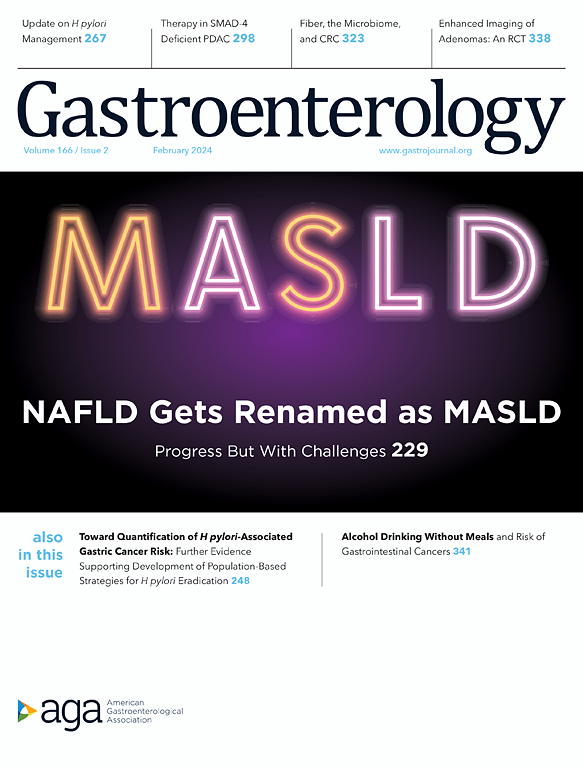Emerging Role of Phosphatidylethanol Testing in Clinical Practice for the Identification of Steatotic Liver Disease Subtypes: Is This the New Standard?
IF 25.7
1区 医学
Q1 GASTROENTEROLOGY & HEPATOLOGY
引用次数: 0
Abstract
Section snippets
Biological Basis and Analytical Characteristics of PEth
PEth is an aberrant phospholipid generated when phospholipase D, in the presence of ethanol, catalyzes a transphosphatidylation reaction that substitutes ethanol for water in phosphatidylcholine.10 Given that PEth molecules carry two fatty acid chains, several isoforms can be observed. Chain lengths range between C14 and C20. The homologues PEth 16:0/18:1 and PEth 16:0/18:2 are the most abundant in human blood, with PEth 16:0/18:1 considered the best and most reliable for detecting alcoholThresholds to Identify SLD Subtypes
Given that PEth correlates quantitatively with alcohol intake, it offers advantages over qualitative markers for assessing consumption in SLD. Several PEth thresholds have been proposed to distinguish MASLD, MetALD, and ALD. The most recent evidence supporting these cut-points will be discussed in the following paragraphs.Studies based on self-reported alcohol have proposed a threshold of 20 ng/mL to determine elevated alcohol intake in the general population.14 In SLD, a study conducted inClinical Pathways Using PEth for SLD Subtype Classification
Because detecting undisclosed alcohol intake is crucial for SLD prognosis, incorporating objective alcohol biomarkers into routine evaluation — just as we measure metabolic dysfunction with glycated hemoglobin, fasting glucose, or lipid profiles — is essential. Drinking patterns can vary substantially over time,22 with binge drinking frequently observed in individuals with SLD.23 Because of its longer detection window, PEth may better capture individuals who engage in binge drinking thanFuture Perspective and Conclusions
The most relevant future directions and unmet needs in the clinical use of PEth are summarized in Table 1. Although PEth represents a major advance in the quantification of ethanol exposure, a single time-point measurement reflects only the preceding month and cannot distinguish between binge drinking and continuous consumption. Serial testing and date-anchored interviews may mitigate misclassification, making it important to interpret them in light of alcohol consumption levels and drinking磷脂酰乙醇检测在鉴别脂肪肝亚型临床实践中的新作用:这是新标准吗?
10 . peth是一种异常磷脂,当磷脂酶D在乙醇的存在下催化转磷脂酰化反应,以乙醇取代磷脂酰胆碱中的水时生成鉴于苯醚分子携带两条脂肪酸链,可以观察到几种同工异构体。链长在C14和C20之间。同源物PEth 16:0/18:1和PEth 16:0/18:2在人类血液中含量最多,PEth 16:0/18:1被认为是检测酒精阈值识别SLD亚型的最佳和最可靠的方法。鉴于PEth与酒精摄入量的定量相关,它比定性标记物更有利于评估SLD的摄入量。已经提出了几种PEth阈值来区分MASLD、MetALD和ALD。下面几段将讨论支持这些分界线的最新证据。基于自我报告酒精含量的研究提出了20纳克/毫升的阈值来确定普通人群酒精摄入量的升高由于检测未公开的酒精摄入量对SLD的预后至关重要,因此将客观的酒精生物标志物纳入常规评估——就像我们用糖化血红蛋白、空腹血糖或脂质谱测量代谢功能障碍一样——是必不可少的。随着时间的推移,饮酒模式会发生很大的变化,22在sld患者中经常观察到酗酒。23由于其更长的检测窗口,PEth可能比PEth更好地捕捉到酗酒的个体。未来的观点和结论PEth在临床应用中最相关的未来方向和未满足的需求总结在表1中。尽管PEth在乙醇暴露量化方面取得了重大进展,但单一时间点的测量只能反映前一个月的情况,无法区分酗酒和连续饮酒。连续测试和日期固定访谈可能会减少错误分类,因此根据酒精消费水平和饮酒情况来解释它们很重要
本文章由计算机程序翻译,如有差异,请以英文原文为准。
求助全文
约1分钟内获得全文
求助全文
来源期刊

Gastroenterology
医学-胃肠肝病学
CiteScore
45.60
自引率
2.40%
发文量
4366
审稿时长
26 days
期刊介绍:
Gastroenterology is the most prominent journal in the field of gastrointestinal disease. It is the flagship journal of the American Gastroenterological Association and delivers authoritative coverage of clinical, translational, and basic studies of all aspects of the digestive system, including the liver and pancreas, as well as nutrition.
Some regular features of Gastroenterology include original research studies by leading authorities, comprehensive reviews and perspectives on important topics in adult and pediatric gastroenterology and hepatology. The journal also includes features such as editorials, correspondence, and commentaries, as well as special sections like "Mentoring, Education and Training Corner," "Diversity, Equity and Inclusion in GI," "Gastro Digest," "Gastro Curbside Consult," and "Gastro Grand Rounds."
Gastroenterology also provides digital media materials such as videos and "GI Rapid Reel" animations. It is abstracted and indexed in various databases including Scopus, Biological Abstracts, Current Contents, Embase, Nutrition Abstracts, Chemical Abstracts, Current Awareness in Biological Sciences, PubMed/Medline, and the Science Citation Index.
 求助内容:
求助内容: 应助结果提醒方式:
应助结果提醒方式:


